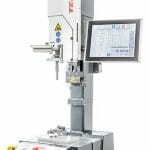“Chirped Pulse Amplification is a method of increasing the energy of what are known as ‘ultrafast’ laser pulses. These are flashes of laser light that are so short that more of them can fit into a single minute than there have been minutes since the Big Bang. Such ultrafast pulses are incredibly useful – for instance they can be used as a kind of strobe light that allows us to track the very fast processes that underpin modern technology such as solar cells and LEDs. However, when you squash light into such a short space of time, you also make it very, very intense.
“Before CPA, this meant that there was a limit to how much energy one of these ultrafast pulses could have. If you tried to amplify them too much, they would quickly become so intense that they would destroy the amplifier. CPA gets round this problem in a really elegant way by, as the name suggests, getting the laser light to ‘chirp’. When we hear a bird chirp, it is producing a burst of sound the pitch of which changes from the start of the sound to the end. In a similar way, the colour of a chirped laser pulse changes from the start to the end. Giving a laser pulse chirp has the effect of stretching it out in time, making it less intense, and so its energy can be greatly increased without destroying the amplifier.
“However, the really clever part about using chirp to stretch the laser pulse is that it can be reversed just as it leaves the amplifier so that the pulse becomes very short again, and the intensity becomes truly immense. For the most powerful lasers of this type, the intensities that can be achieved are astounding – greater even than found in the centre of the sun. This is opening up whole new areas of physics, such as using lasers for particle acceleration and for nuclear fusion.”







